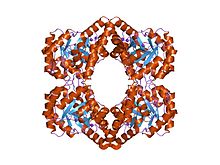- Dihydrodipicolinate synthase
-
dihydrodipicolinate synthase Identifiers EC number 4.2.1.52 CAS number 9055-59-8 Databases IntEnz IntEnz view BRENDA BRENDA entry ExPASy NiceZyme view KEGG KEGG entry MetaCyc metabolic pathway PRIAM profile PDB structures RCSB PDB PDBe PDBsum Gene Ontology AmiGO / EGO Search PMC articles PubMed articles Dihydrodipicolinate synthetase family 
crystal structure of dihydrodipicolinate synthase dapa-2 (ba3935) from bacillus anthracis at 1.94a resolution. Identifiers Symbol DHDPS Pfam PF00701 Pfam clan CL0036 InterPro IPR002220 PROSITE PDOC00569 SCOP 1dhp Available protein structures: Pfam structures PDB RCSB PDB; PDBe PDBsum structure summary In enzymology, a dihydrodipicolinate synthase (EC 4.2.1.52) is an enzyme that catalyzes the chemical reaction
- L-aspartate 4-semialdehyde + pyruvate
 (S)-2,3-dihydropyridine-2,6-dicarboxylate + 2 H2O
(S)-2,3-dihydropyridine-2,6-dicarboxylate + 2 H2O
Thus, the two substrates of this enzyme are L-aspartate 4-semialdehyde and pyruvate, whereas its two products are (S)-2,3-dihydropyridine-2,6-dicarboxylate and H2O.
This enzyme belongs to the family of lyases, specifically the hydro-lyases, which cleave carbon-oxygen bonds. The systematic name of this enzyme class is L-aspartate-4-semialdehyde hydro-lyase [adding pyruvate and cyclizing; (S)-2,3-dihydropyridine-2,6-dicarboxylate-forming]. Other names in common use include dihydropicolinate synthetase (DHDPS), dihydrodipicolinic acid synthase, L-aspartate-4-semialdehyde hydro-lyase (adding pyruvate and, and cyclizing). This enzyme participates in lysine biosynthesis.
Dihydropicolinate synthase is the key enzyme in lysine biosynthesis via the diaminopimelate pathway of prokaryotes, some phycomycetes and higher plants. The enzyme catalyses the condensation of L-aspartate-beta- semialdehyde and pyruvate to dihydropicolinic acid via a ping-pong mechanism in which pyruvate binds to the enzyme by forming a Schiff base with a lysine residue.[1] Three other proteins are structurally related to DHDPS and probably also act via a similar catalytic mechanism. These are Escherichia coli N-acetylneuraminate lyase (EC 4.1.3.3) (gene nanA), which catalyses the condensation of N-acetyl-D-mannosamine and pyruvate to form N-acetylneuraminate; Rhizobium meliloti (Sinorhizobium meliloti) protein mosA,[2] which is involved in the biosynthesis of the rhizopine 3-o-methyl-scyllo-inosamine; and E. coli hypothetical protein yjhH. The sequences of DHDPS from different sources are well-conserved. The structure takes the form of a homotetramer, in which 2 monomers are related by an approximate 2-fold symmetry.[1] Each monomer comprises 2 domains: an 8-fold alpha-/beta-barrel, and a C-terminal alpha-helical domain. The fold resembles that of N-acetylneuraminate lyase. The active site lysine is located in the barrel domain, and has access via 2 channels on the C-terminal side of the barrel.
Structural studies
As of late 2007, 16 structures have been solved for this class of enzymes, with PDB accession codes 1DHP, 1O5K, 1S5T, 1S5V, 1S5W, 1XKY, 1XL9, 1XXX, 1YXC, 1YXD, 2A6L, 2A6N, 2ATS, 2D5K, 2EHH, and 2PCQ.
References
- ^ a b Mirwaldt C, Korndorfer I, Huber R (February 1995). "The crystal structure of dihydrodipicolinate synthase from Escherichia coli at 2.5 A resolution". J. Mol. Biol. 246 (1): 227–39. doi:10.1006/jmbi.1994.0078. PMID 7853400.
- ^ Murphy PJ, Trenz SP, Grzemski W, De Bruijn FJ, Schell J (August 1993). "The Rhizobium meliloti rhizopine mos locus is a mosaic structure facilitating its symbiotic regulation". J. Bacteriol. 175 (16): 5193–204. PMC 204987. PMID 8349559. http://www.pubmedcentral.nih.gov/articlerender.fcgi?tool=pmcentrez&artid=204987.
Further reading
- Shedlarski JG, Gilvarg C (1970). "The pyruvate-aspartic semialdehyde condensing enzyme of Escherichia coli". J. Biol. Chem. 245 (6): 1362–73. PMID 4910051.
- Yugari Y, Gilvarg C (1965). "The condensation step in diaminopimelate synthesis". J. Biol. Chem. 240 (12): 4710–6. PMID 5321309.
This EC 4.2 enzyme-related article is a stub. You can help Wikipedia by expanding it. - L-aspartate 4-semialdehyde + pyruvate
